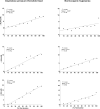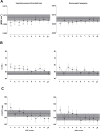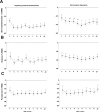Non-invasive assessment of fatigue and recovery of inspiratory rib cage muscles during endurance test in healthy individuals
- PMID: 36477075
- PMCID: PMC9728934
- DOI: 10.1371/journal.pone.0277131
Non-invasive assessment of fatigue and recovery of inspiratory rib cage muscles during endurance test in healthy individuals
Abstract
Introduction: Fatigue is defined as loss of capacity to develop muscle force and/or velocity that is reversible at rest. We assessed non-invasively the fatigue and recovery of inspiratory rib cage muscles during two respiratory endurance tests in healthy individuals.
Methods: The sniff nasal inspiratory pressure (SNIP) was assessed before and after two respiratory endurance tests: normocapnic hyperpnea (NH) and inspiratory pressure threshold loading (IPTL). Contractile (maximum rate of pressure development and time to peak pressure) and relaxation parameters (maximum relaxation rate [MRR], time constant of pressure decay [τ], and half relaxation time) obtained from sniff curves and shortening velocity and mechanical power estimated using optoelectronic plethysmography were analyzed during SNIP maneuvers. Respiratory muscle activity (electromyography) and tissue oxygenation (near-infrared spectroscopy-NIRS) were obtained during endurance tests and SNIP maneuvers. Fatigue development of inspiratory rib cage muscles was assessed according to the slope of decay of median frequency.
Results: Peak pressure during SNIP decreased after both protocols (p <0.05). MRR, shortening velocity, and mechanical power decreased (p <0.05), whereas τ increased after IPTL (p <0.05). The median frequency of inspiratory rib cage muscles (i.e., sum of sternocleidomastoid, scalene, and parasternal) decreased linearly during IPTL and exponentially during NH, mainly due to the sternocleidomastoid.
Conclusion: Fatigue development behaved differently between protocols and relaxation properties (MRR and τ), shortening velocity, and mechanical power changed only in the IPTL.
Copyright: © 2022 Wanderley e Lima et al. This is an open access article distributed under the terms of the Creative Commons Attribution License, which permits unrestricted use, distribution, and reproduction in any medium, provided the original author and source are credited.
Conflict of interest statement
The authors have declared that no competing interests exist.
Figures








Similar articles
-
Changes in electromyographic activity, mechanical power, and relaxation rates following inspiratory ribcage muscle fatigue.Sci Rep. 2021 Jun 14;11(1):12475. doi: 10.1038/s41598-021-92060-y. Sci Rep. 2021. PMID: 34127754 Free PMC article.
-
Effects of diaphragmatic control on multiparametric analysis of the sniff nasal inspiratory pressure test and inspiratory muscle activity in healthy subjects.PLoS One. 2021 Jul 22;16(7):e0253132. doi: 10.1371/journal.pone.0253132. eCollection 2021. PLoS One. 2021. PMID: 34292943 Free PMC article.
-
Noninvasive assessment of respiratory muscle strength and activity in Myotonic dystrophy.PLoS One. 2017 Jun 8;12(6):e0177318. doi: 10.1371/journal.pone.0177318. eCollection 2017. PLoS One. 2017. PMID: 28594857 Free PMC article.
-
Respiratory function of the rib cage muscles.Eur Respir J. 1993 May;6(5):722-8. Eur Respir J. 1993. PMID: 8519384 Review.
-
Monitoring respiratory muscles.Monaldi Arch Chest Dis. 1998 Dec;53(6):640-3. Monaldi Arch Chest Dis. 1998. PMID: 10063336 Review.
Cited by
-
The effect of inspiratory muscle training on the inspiratory muscle metaboreflex: A systematic review.Can J Respir Ther. 2025 Mar 24;61:51-59. doi: 10.29390/001c.132324. eCollection 2025. Can J Respir Ther. 2025. PMID: 40161511 Free PMC article.
-
Ultrasonographic evaluation of diaphragm fatigue in healthy humans.Exp Physiol. 2025 Mar;110(3):478-493. doi: 10.1113/EP092322. Epub 2025 Jan 9. Exp Physiol. 2025. PMID: 39780750 Free PMC article.
References
Publication types
MeSH terms
LinkOut - more resources
Full Text Sources

